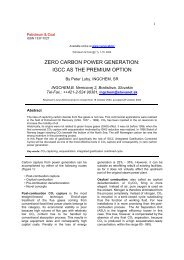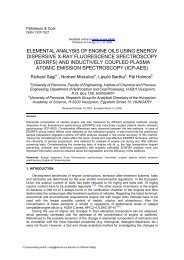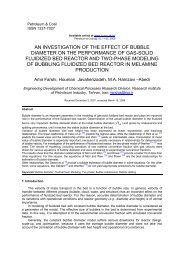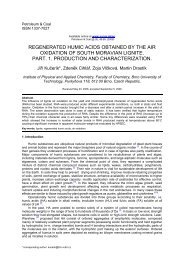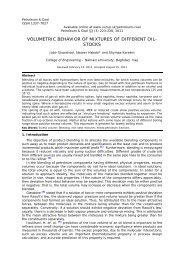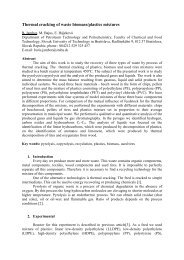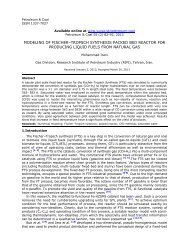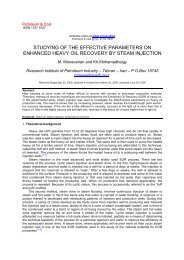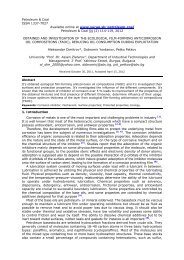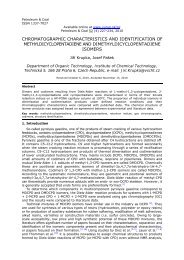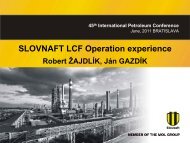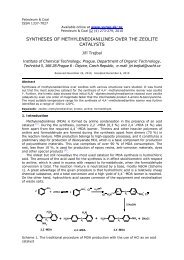Oxidation Stability of Lubricants Measured by a PDSC Technique
Oxidation Stability of Lubricants Measured by a PDSC Technique
Oxidation Stability of Lubricants Measured by a PDSC Technique
You also want an ePaper? Increase the reach of your titles
YUMPU automatically turns print PDFs into web optimized ePapers that Google loves.
56<br />
Peet trool<br />
lleeuum & Cooaal ll<br />
ISSN 1337-7027<br />
Available online at www.vurup.sk/pc<br />
Petroleum & Coal 46 (3), 56-62, 2004<br />
<strong>Oxidation</strong> <strong>Stability</strong> <strong>of</strong> <strong>Lubricants</strong> <strong>Measured</strong> <strong>by</strong> a<br />
<strong>PDSC</strong> <strong>Technique</strong><br />
Jaroslav Černý, Miroslav Zelinka*<br />
Department <strong>of</strong> Petroleum Technology and Petrochemistry, Institute <strong>of</strong><br />
Chemical Technology, Technická 5, CZ-16628 Prague, Czech Republic<br />
• Texaco <strong>Lubricants</strong> v.o.s., Špitálská 2a, CZ-19000 Prague,<br />
Czech Republic<br />
Abstract<br />
A methodology was developed for evaluation <strong>of</strong> oxidation stability <strong>of</strong> base stocks and engine oils. Analytical<br />
procedures for both classes <strong>of</strong> lubricants were based on the ASTM standards D 6186 and/or E<br />
2009. The procedures were applied to a set <strong>of</strong> engine oils <strong>of</strong> the SAE 5W-30 specification, and to a set<br />
<strong>of</strong> several hydrocracked and solvent neutral base oils, both with and without addition <strong>of</strong> antioxidant. A<br />
potential <strong>of</strong> a pressure DSC for diagnostic purpose was also demonstrated <strong>by</strong> monitoring the engine oil<br />
ageing during its operation in heavy-duty engine.<br />
Keywords: base oil, engine oil, oxidation stability, pressure DSC<br />
Introduction<br />
Differential scanning calorimetry (DSC) was<br />
used for evaluation <strong>of</strong> oxidation stability <strong>of</strong><br />
lubricating oils as early as in the sixties.<br />
However, the large potential <strong>of</strong> DSC could<br />
only be exploited in the nineties after the<br />
pressure DSC (<strong>PDSC</strong>) became available.<br />
Analysis under increased pressure brought<br />
a better baseline stability due to a limited<br />
evaporation <strong>of</strong> samples and the analysis<br />
time was also shortened. One <strong>of</strong> the first<br />
applications <strong>of</strong> the pressure DSC technique<br />
was published in 1980 [1] .<br />
<strong>PDSC</strong> allows a variable temperature programs<br />
and a choice <strong>of</strong> oxidising gas (oxygen,<br />
air) for analyses. Evaluation <strong>of</strong> oxidation<br />
stability <strong>of</strong> lubricating oils can be done<br />
under isothermal as well as non-isothermal<br />
conditions. Effects affecting the oil oxidation<br />
in the <strong>PDSC</strong> cell (such as temperature, oxygen<br />
pressure and flow rate) were evaluated<br />
and described elsewhere [2,3] . Analytical procedures<br />
for evaluation <strong>of</strong> oxidation stability<br />
<strong>of</strong> lubricating were also standardised and the<br />
two most popular standards are the ASTM<br />
D 6186 and E 2009 corresponding to the<br />
isothermal and non-isothermal techniques,<br />
respectively. The <strong>PDSC</strong> test procedure<br />
CEC-L-85-T-99 is also one <strong>of</strong> the tests included<br />
in the specifications ACEA E5 and<br />
Global DHD-1 for engine oils for heavy-duty<br />
engines.<br />
This paper presents some results and experience<br />
with a <strong>PDSC</strong> analysis <strong>of</strong> fresh as<br />
well as operating motor oils, hydrocarbon<br />
base oils, and bio-diesel fuel. Effect <strong>of</strong> a low<br />
temperature antioxidant in different base oils<br />
has also been evaluated.
57<br />
Experimental<br />
Isothermal analysis according to ASTM D<br />
6186<br />
standard open Al pan and placed in the<br />
measuring cell. Temperature <strong>of</strong> the cell was<br />
increased from the ambient to the temperature<br />
<strong>of</strong> 200°C at a rate <strong>of</strong> 100°C/min and<br />
allowed to equilibrate for 2 min. After that<br />
period the cell was pressurized <strong>by</strong> oxygen to<br />
3.5 MPa and the purge gas flow rate was<br />
adjusted at 100 ml/min. The oxidation induction<br />
time (OIT) was measured from the time<br />
the oxygen valve was opened. Detection <strong>of</strong><br />
OIT was made <strong>by</strong> an extrapolation <strong>of</strong> the<br />
DSC signal when a strong exothermic reaction<br />
(oxidation) was detected (see Fig. 1).<br />
When short OIT below 10 min is detected,<br />
the oxidation temperature should be decreased<br />
to 180°C (further to 155°C and<br />
130°C).<br />
About 3 mg <strong>of</strong> a sample was weighed into a<br />
Non-isothermal analysis ASTM E 2009<br />
Again about 3 mg <strong>of</strong> a sample was prepared<br />
as in the previous method. Temperature was<br />
increased from ambient <strong>by</strong> the gradient <strong>of</strong><br />
10°C /min. Oxygen pressure was maintained<br />
at 3.5 MPa from the start <strong>of</strong> heating. Flow<br />
rate was adjusted to 50 ml/min. A similar<br />
signal to that in Fig. 1 was obtained and the<br />
oxidation onset temperature (OOT) was<br />
evaluated.<br />
60<br />
DSC signal (mW)<br />
40<br />
20<br />
0<br />
OIT 41.8 min<br />
0 10 20 30 40 50 60 70<br />
<strong>Oxidation</strong> induction time (min)<br />
Figure 1<br />
Pressure DSC analysis <strong>of</strong> engine oil
58<br />
Results and Discussion<br />
Motor oils<br />
Engine oils were analysed <strong>by</strong> the isothermal<br />
procedure according to ASTM D 186. However,<br />
the temperature <strong>of</strong> <strong>PDSC</strong> analysis was<br />
decreased <strong>by</strong> 10 °C, which led to approximately<br />
doubled OIT`s (initial temperature<br />
recommended <strong>by</strong> the ASTM D 6186 is 210<br />
°C). According our experience, temperature<br />
<strong>of</strong> 200 °C is more suitable for modern engine<br />
oils. Analysing more than 70 motor oils <strong>of</strong><br />
different specifications and from different<br />
producers the OIT`s obtained were all in the<br />
range from 13 min to more than 120 min.<br />
This range allows very well differentiating<br />
between individual oils. OIT <strong>of</strong> most <strong>of</strong> the<br />
motor oils were from 30 min. to 50 min.<br />
<strong>Oxidation</strong> induction times express the potential<br />
<strong>of</strong> engine oil to fight against oxidation. During<br />
the induction period, oxidation reactions and<br />
oxidation extent are influenced <strong>by</strong> antioxidants.<br />
Even after consumption <strong>of</strong> the antioxidants the<br />
hydrocarbon chains can be oxidised <strong>by</strong> a radical<br />
mechanism [4] and an exothermic effect can<br />
clearly be seen in the DSC output signal<br />
(Fig. 1). The OIT can thus be considered as a<br />
factor that is someway proportional to the antioxidant<br />
capacity <strong>of</strong> motor oils and other lubricants.<br />
<strong>PDSC</strong> analysis is powerful, for example, in<br />
comparing oxidation stability <strong>of</strong> engine oils. In<br />
Fig. 2, there is a comparison <strong>of</strong> oxidation stability<br />
<strong>of</strong> SAE 5W-30 oils from different producers<br />
expressed as OIT`s from <strong>PDSC</strong> analysis.<br />
There were large differences between OIT`s<br />
<strong>of</strong> individual engine oils. Whereas oils with<br />
the European specification ACEA A3/B3,B4<br />
had very good oxidation stability (with an<br />
extreme example <strong>of</strong> the Oil B), among oils<br />
with the specification ACEA A1/B1 and with<br />
HTHS viscosity < 3.5 mPa.s there were<br />
some oils with rather poor oxidation stability<br />
(see oils D and E in Fig. 2).<br />
60<br />
> 120<br />
OIT/200°C (min)<br />
40<br />
20<br />
Figure 2<br />
0<br />
A B C D E F G H I J<br />
Motor Oil<br />
<strong>Oxidation</strong> stability <strong>of</strong> SAE 5W-30 motor oils <strong>by</strong> <strong>PDSC</strong>
59<br />
Another example <strong>of</strong> <strong>PDSC</strong> utilization can be<br />
in the field <strong>of</strong> tribodiagnostics [5,6] . In Fig. 3<br />
there is shown a decrease <strong>of</strong> OIT during<br />
operation <strong>of</strong> oil in a heavy-duty engine Volvo<br />
FH12. Drain interval <strong>of</strong> motor oil in the engine<br />
is 40 000 km, however, the oil was<br />
operated for up to 67 000 km. There is<br />
clearly an exponential decay <strong>of</strong> OIT`s showing<br />
that much <strong>of</strong> the antioxidant capacity <strong>of</strong><br />
engine oil was consumed during the first 20<br />
000 km. Moreover, another aspect in analysis<br />
<strong>of</strong> operating oils is very important. Operating<br />
and/or used motor oils should be analysed<br />
at a lower temperature. At a temperature<br />
<strong>of</strong> 200 °C the OIT`s obtained were too<br />
low especially in the final stage <strong>of</strong> the oil life.<br />
More appropriate results can be obtained<br />
analysing the oils at 180°C. Values <strong>of</strong> the<br />
OIT were about five times higher, and differences<br />
in OIT for neighbouring samples were<br />
quite recognizable even in the final stage <strong>of</strong><br />
the oil life.<br />
120<br />
100<br />
ASTM D6186/180 °C<br />
80<br />
OIT (min)<br />
60<br />
40<br />
20<br />
ASTM D6186/200 °C<br />
0<br />
0 20 40 60<br />
Mileage (thousands km)<br />
Figure 3<br />
Decrease <strong>of</strong> OIT <strong>of</strong> motor oil during operation in a heavy-duty engine Volvo FH12<br />
In the next Fig. 4 a similar plot is shown for<br />
motor oil operating in a personal car Škoda<br />
Octavia 1.9 TDi with a prolonged oil drain<br />
interval (up to 50 000 km). Depletion <strong>of</strong> antioxidant<br />
and lowering the oil antioxidation<br />
capacity during operation is there again<br />
clearly seen. Very interesting is also the<br />
effect <strong>of</strong> oil filling up on the antioxidation<br />
capacity that is clearly demonstrated <strong>by</strong> a<br />
<strong>PDSC</strong> analysis. Repeated addition <strong>of</strong> a fresh<br />
oil led to stabilising the antioxidation capacity<br />
<strong>of</strong> the operating motor oil. There are only a<br />
few alternatives in tribodiagnostics, if any,<br />
with such a clear response to a fresh oil<br />
addition as the <strong>PDSC</strong> analysis. The experiment<br />
is still in progress and samples <strong>of</strong> the<br />
motor oil will be collected up to the time <strong>of</strong><br />
the car computer warning.
60<br />
OIT/180°C (min)<br />
70<br />
60<br />
50<br />
40<br />
30<br />
fill-up +0.5 litre<br />
fill-up +0.5 litre<br />
fill-up +0.5 litre<br />
fill-up +0.8 litre<br />
20<br />
10<br />
0 10 20 30 40<br />
Mileage (thousands km)<br />
Figure 4 Decrease <strong>of</strong> OIT <strong>of</strong> motor oil during operation in a personal car Škoda Octavia 1.9<br />
TDi (diesel fueled)<br />
Base oils and hydrocarbon mixtures<br />
Usage <strong>of</strong> an isothermic procedure is not the<br />
best choice for evaluation <strong>of</strong> oxidation stability<br />
<strong>of</strong> base oils. The OIT`s are very low, below<br />
5 min, even if temperature is lowered to<br />
about 170 °C. Moreover, lower temperatures<br />
lead to a broad DSC signals with a low intensity.<br />
A better choice is the non-isothermal<br />
procedure that leads to a similar signal as in<br />
Fig. 1. A disadvantage <strong>of</strong> the non-isothermal<br />
method is a possibility <strong>of</strong> larger experimental<br />
errors. Most <strong>of</strong> base oils have their OOT`s<br />
between 190 o C and 230°C. It means that<br />
OOT <strong>of</strong> those base oils are detected within 4<br />
minutes at the gradient <strong>of</strong> 10°C /min. There<br />
is much less opportunity to distinguish between<br />
two base oils with close oxidation<br />
stability.<br />
In Fig. 5, there is shown a comparison <strong>of</strong><br />
oxidation stability for several base oils, hydrocracked<br />
as well as solvent neutral, and<br />
for the same oils with 0.4 wt % <strong>of</strong> antioxidant<br />
BHT.<br />
It is apparent from Fig. 5 that SN oils were,<br />
under the <strong>PDSC</strong> conditions, much more<br />
oxidatively stable than HC oils. Even after<br />
addition <strong>of</strong> BHT, oxidation stability <strong>of</strong> HC<br />
based oils was mostly lower than that <strong>of</strong> SN<br />
base oils. It does not correspond to a praxis<br />
experience that turbine oils based on HC oils<br />
are much more stable than those based on<br />
SN oils. That is most likely due to a high<br />
temperature character <strong>of</strong> oxidation as the<br />
OOT`s were detected around 200°C. Turbine<br />
oils are known as oils operating at low<br />
temperatures where a quite different oxidation<br />
mechanism occurs with respect to an oil<br />
composition [4]. Even incorporation <strong>of</strong> a 60<br />
min. isothermal step at 150°C (temperature<br />
<strong>of</strong> usual RBOT test) before detecting the<br />
OOT did not have a substantial effect on<br />
oxidation HC and SN oils.
61<br />
240<br />
220<br />
OOT (°C)<br />
200<br />
180<br />
160<br />
HC-A HC-B HC-C HC-D SN-A SN-B SN-C SN-D<br />
HC and SN base oils<br />
0.4 wt % BHT<br />
Figure 5<br />
<strong>Oxidation</strong> stability <strong>of</strong> some HC and SN oils and effect <strong>of</strong> the BHT antioxidant<br />
Another example for utilisation <strong>of</strong> a <strong>PDSC</strong><br />
evaluation <strong>of</strong> oxidation stability <strong>of</strong> hydrocarbon<br />
and similar mixtures is shown in Fig. 6.<br />
Rape seed methyl esters were added to a<br />
conventional diesel fuels in different concentration<br />
up to 35 wt %. There is clearly seen a<br />
rapid decrease <strong>of</strong> oxidation stability <strong>of</strong> biodiesel<br />
while adding the first ten percent <strong>of</strong><br />
RME into a conventional diesel fuel. Further<br />
increase <strong>of</strong> the RME concentration did not<br />
affect the oxidation stability <strong>of</strong> biodiesel as<br />
much as small percentage <strong>of</strong> RME.<br />
220<br />
Onset temperature (°C)<br />
210<br />
200<br />
190<br />
180<br />
170<br />
0 10 20 30<br />
RME concentration (wt %)<br />
Figure 6<br />
<strong>Oxidation</strong> stability <strong>of</strong> biodiesel fuel <strong>by</strong> <strong>PDSC</strong> technique
62<br />
Conclusion<br />
A pressure DSC is a very useful tool for evaluation <strong>of</strong> oxidation stability <strong>of</strong> lubricating oils. Small<br />
sample amount and analysis duration mostly up to 60 min are the main advantages. It is especially<br />
suitable for evaluation <strong>of</strong> high temperature oxidation. <strong>PDSC</strong> has a great potential for its utilization<br />
in the field <strong>of</strong> tribodiagnostics <strong>of</strong> oil ageing and for a rapid assessment <strong>of</strong> oxidation stability<br />
<strong>of</strong> lubricating oils and other hydrocarbon mixtures.<br />
Acknowledgement. The work was sponsored <strong>by</strong> the National Research Center for a Complex<br />
Petroleum Treatment under the project agreement No. LN 00B142.<br />
5 References<br />
[1] Walker, J. A., and Tsang, W., "Characterization <strong>of</strong> Oils <strong>by</strong> Differential Scanning Calorimetry",<br />
SAE Tech. Pap. 801383, 1980<br />
[2] Blaine, R. L., Lundgren C. J., and Harris M. B., "Oxidative Induction Time - A Review <strong>of</strong><br />
DSC Experimental Effects", ASTM STP 1326, pp. 3-15, 1997<br />
[3] Keller, M. A., and Saba, C. S., "Behavior <strong>of</strong> High Temperature <strong>Lubricants</strong> in a Pressure<br />
Differential Scanning Calorimeter, Tribol. Trans. 1998, 41(4), 586-592<br />
[4] Černý, J., "Principles <strong>of</strong> low- and high-temperature oxidation <strong>of</strong> hydrocarbon mixtures",<br />
Proc. 7th Conf. REOTRIB 2001, Velké Losiny, May 2001, pp. 45-54 (in Czech)<br />
[5] Bowman, W. F., and Stachowiak, Q. W., "Determining the <strong>Oxidation</strong> <strong>Stability</strong> <strong>of</strong> Lubricating<br />
Oils Using Sealed Capsule DSC", Tribol. Int. 1996, 29(1), 27-32<br />
[6] Bijwe, J., Garg, A., and Gandhi, O. P., "Reassessment <strong>of</strong> Engine Oil Periodicity in Commercial<br />
Vehicles", Lubr. Eng. 2000, 56(1), 23-29



